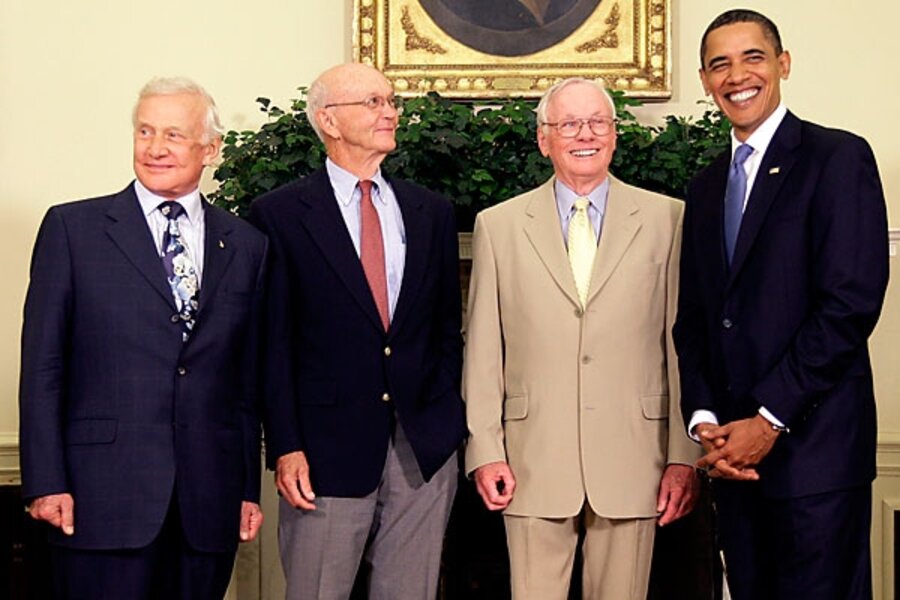Where should NASA go next: moon or Mars?
Loading...
Grab your coat, Frank. We're headed for: A. The moon. B. Mars. C. Neither.
If it were up to two of the three Apollo 11 astronauts, the answer would be: B. Mars.
The mission's three astronauts headed to the White House Monday to celebrate the 40th anniversary of an historic achievement – setting foot for the first time on another celestial object. At least two of them – Neil Armstrong and Buzz Aldrin – were expected to urge President Obama to set the nation's human spaceflight sights on the red planet rather than the moon.
Each mission has passionate advocates. Each presents planners with unique challenges.
Comparing the moon and Mars
The moon has no atmosphere. It has little gravity – about 17 percent that of Earth's at the surface. Its day and night each span roughly 14 Earth days, subjecting explorers and their hardware to searing temperatures followed by a long, deep freeze. And with no wind to smooth out its sharp edges, lunar dust poses a serious hazard.
In return, the moon has a few things to offer. Advocates, including former Apollo 17 astronaut Harrison Schmidt, point to the abundance of helium-3, which can be used to generate energy in future fusion reactors. And if tantalizing hints of water ice at the bottom of the moon’s polar craters turn out true, explorers would have a ready source of rocket fuel – once they split the water into hydrogen and oxygen.
And, of course, the moon is only three or four days away.
Mars, on the other hand, is eight months away even at the point where Eartns and Mars are closest in their orbits of the sun. Once you get there, the first spaceship home doesn't leave for a year or so. It awaits the next close approach between the two planets.
But Mars has an atmosphere of carbon dioxide that, with some clever chemistry, can be tapped for fuel, advocates say. The red planet's gravity is a little more Earth-like at about 38 percent of Earth's gravity. It has a comparable day-night cycle: One Martian day is 24 hours, 39 minutes long. Temperatures range from winter lows at the poles as cold as -207 degrees Fahrenheit (far colder than an Antarctic winter) to occasional summer highs of near 80 degrees F in some spots. It's known to have water ice. And an initial analysis of minerals by the Mars Phoenix Lander suggest that with slight modification, Martian soil might be suitable for growing food.
Put the brochures side by side, and it sounds like Mars is the more-desirable destination.
Skeptics, however, point to a range of obstacles that can be overcome only at high cost, given current technology. In the June issue of the IEEE Spectrum, science writers Fred Guterl and Monica Heger list several of them: rocket motors barely up to the task of getting there, cosmic rays, crew stress, bone and muscle problems related to operating in low or no gravity, and the ensuring enough groceries.
Mars by 2016?
For longtime Mars advocate, Robert Zubrin, these difficulties shouldn't be showstoppers. He points out that President Kennedy said he picked the goal of a moon landing not because it was easy, but because it was hard.
If the president gives NASA a firm timetable and an adequate budget (say, roughly $40 billion over eight years), humans could land on Mars by 2016 or 2017, with the hardware necessary to sustain themselves and conduct groundbreaking planetary research.
The cost, Mr. Zubrin acknowledges, is not trivial. But, he notes, “It's much less than the amount we gave to AIG in an afternoon.”
The key, he says, is holding NASA to a Kennedy-like deadline.
The 1963 moment
But historians point out that for all the talk of Mars as an inspiring space goal, the one element present in 1963 and missing today is a strong sense of national urgency that was driven by a cold war with an ideological foe. The USSR already had beaten the US in putting into orbit the first satellite and the first human. Kennedy sought a space project the US had a good chance of beating the Soviets – a moon landing became the chosen path.
And even Kennedy reportedly blanched when he saw the initial price tag. Space historian Roger Launius, curator of the Smithsonian Institutions Air and Space Museum in Washington, has noted that once Kennedy saw the cost, he began to speak of space exploration in more international terms, and even raised the issue of cooperation with then Soviet Premier Nikita Krushchev.
Dr. Zubrin, an aerospace engineer, says his Mars approach would certainly benefit from international cooperation, especially in spreading the cost out among several players.
But, he adds, “I don't think the program should be held hostage” to the willingness of other countries to take part.
[Editor's note: The original version of this story mistakenly referred to the moon as "another planet."]





